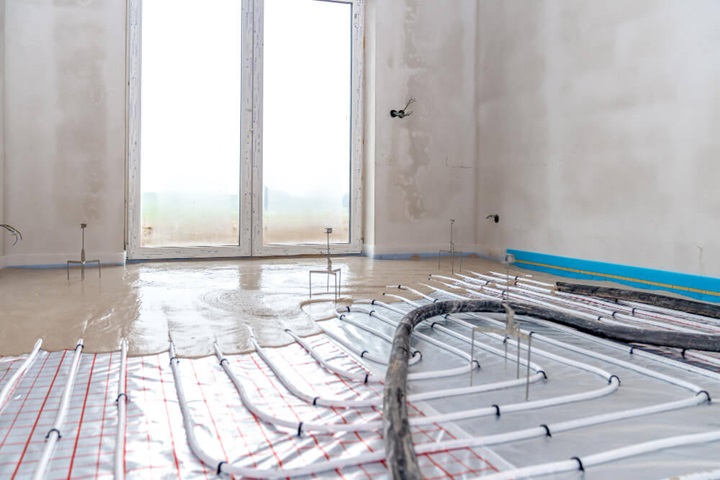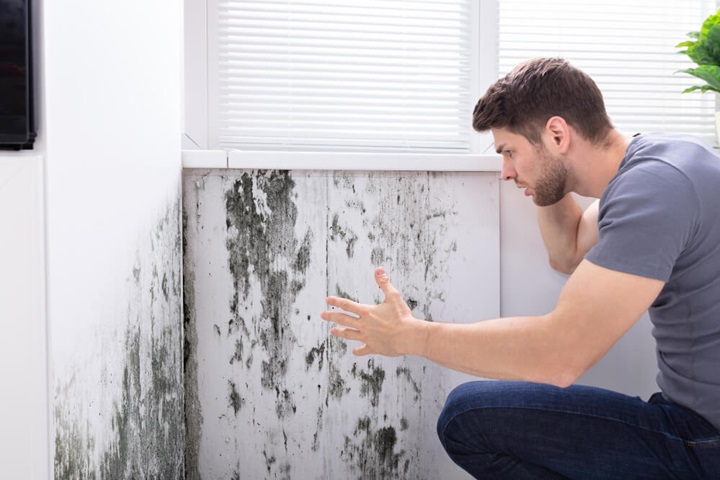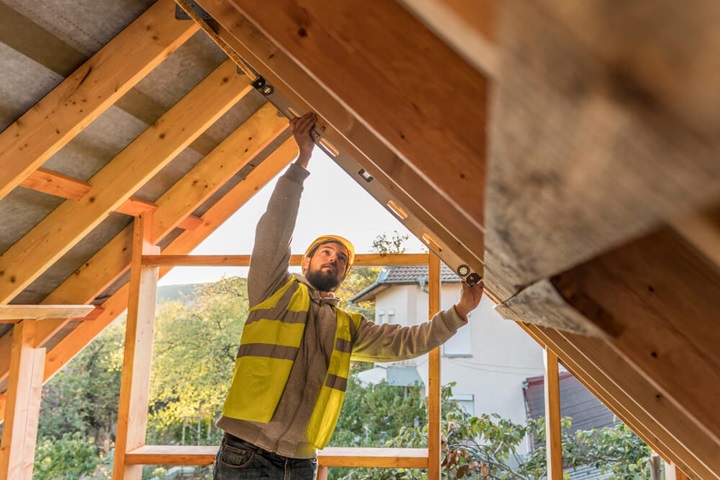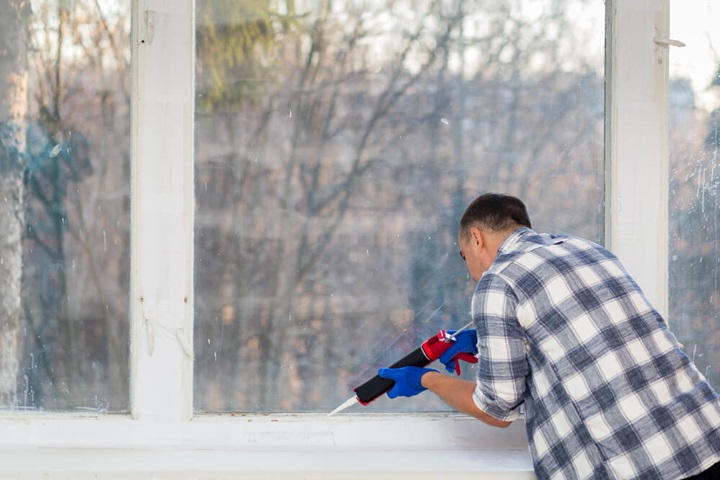Are you worried about how much heat escapes your home during the colder months? Adding underfloor heating to your home can drastically reduce how much heat is lost when times get cold.
Heat loss in UK homes is a profound problem. No matter whether you live in a new build, contemporary home, or old property, you are bound to come across heat escaping from where. Understanding where heat loss occurs can help you keep your house warmer and reduce energy bills. In this article, we will explain the main causes of heat loss in houses, such from walls, roofs, and windows, and offers practical tips to improve insulation and prevent damp. You’ll learn how to identify problem areas and take simple steps to make your home more energy efficient.
Key Points:
- Where most heat is lost in UK homes.
- How damp affects heat loss and energy costs.
- Easy ways to improve insulation and reduce heat escape.
- The importance of upgrading windows and roof insulation.
- Tips for maintaining a warm, energy-efficient home.
- What Causes Heat Loss in Homes?
- Where Is The Most Heat Loss In A House UK?
- How Much Heat Is Lost Through The Walls and Roof?
- What Can Be Done Regarding Your House Losing Heat?
- 6 Ways on How to Increase Thermal Efficiency in Your Home
- 1. Add Underfloor Heating
- 2. Protect Walls from Moisture
- 3. Insulating Your Roof
- 4. Upgrading Windows
- 5. Ventilation to Prevent Condensation and Damp Issues
- 6. Are Dehumidifiers Cost-Effective?
- FAQs
- Sources
What Causes Heat Loss in Homes?
Heat loss in houses happens through different parts of the building, especially if it isn’t properly insulated. The most common areas where a house loses heat are the walls, roof, windows, and floors.
Knowing where the most heat loss in a house can be a big help in tackling the problem effectively. In many cases, the house losing heat the most is through the walls and roof, which together can account for a significant portion of heat escape.
Where Is The Most Heat Loss In A House UK?
In the UK, the biggest heat loss usually comes from the walls and roof. According to Energy Saving Trust, at least 33% of heat loss is caused through poor wall insulation, making the house colder and increasing energy bills.
The type of walls also matters; older homes often have solid walls, which lose heat faster than cavity walls that can be filled with insulation. The amount of heat lost through the walls depends on how well they’re insulated and whether they have draught-proofing.
Similarly, the roof is another major source of heat loss. A house losing heat through the roof can lose up to 25% of its warmth if the attic or loft isn’t properly insulated. Heat rises naturally, so without good insulation, it escapes through the roof and attic spaces, making it harder to keep the home warm.
How Much Heat Is Lost Through The Walls and Roof?
The exact amount varies depending on the age and condition of the home. On average, a poorly insulated wall can let through a lot of heat, especially if it’s a solid wall or has gaps.
The same goes for the roof, where a lack of insulation can result in a significant amount of heat escaping. For example, if your roof isn’t insulated, you could be losing a quarter of your heat just through that area alone.
What Can Be Done Regarding Your House Losing Heat?
To reduce heat loss in houses, it’s important to focus on insulating the walls and roof first. Adding cavity wall insulation or external/internal wall insulation can make a big difference. For the roof, installing loft or attic insulation will help keep the warmth inside.
These simple steps can lower the amount of heat lost through the walls and roof, and in turn, cut down on energy bills.
Addressing these key areas not only helps maintain a warmer home but also reduces the amount of heat lost in a house, making it easier to keep comfortable during the colder months.
6 Ways on How to Increase Thermal Efficiency in Your Home
Living in the UK means dealing with wet and windy weather, which can have a big impact on the heat retention of your home. When brickwork and masonry absorb moisture, they lose more heat, making it harder to keep your house warm.
To stop this from happening and reduce heat loss in houses, it’s important to protect your property from the elements and improve its thermal performance.
1. Add Underfloor Heating

Underfloor heating is an effective way to reduce heat loss in houses, especially when combined with good insulation. Unlike traditional radiators, a wet underfloor heating system distributes warmth evenly across the floor, helping to keep the room warmer with less energy. This reduces the need to leave your heating on constantly during winter, saving you money and lowering energy bills.
For homes with existing floors, overlay underfloor heating is a simple, efficient upgrade that can be installed over existing surfaces without major disruption.
To maximize the benefits of underfloor heating, it’s important to follow the loft insulation dos and don’ts, ensuring your home retains heat effectively. Proper insulation combined with an efficient heating system helps prevent heat from escaping through the roof or walls. Whether you’re considering a wet underfloor heating setup or just want to know if you should leave your underfloor heating on constantly in the winter, our products and advice are designed to help you reduce heat loss and stay warm efficiently.
2. Protect Walls from Moisture

Another way to reduce heat loss in houses is to prevent water from entering the walls. Driving rain can soak into brickwork, causing damp and weakening the structure over time. Wet walls conduct heat quicker, too, leading to higher heat loss in a house. This not only makes your home colder but also increases your energy bills.
3. Insulating Your Roof

Another effective way to increase thermal efficiency is to insulate the roof properly. Loft insulation is affordable, easy to install, and pays for itself in savings within a couple of years. It keeps the heat inside your home, preventing it from escaping through the roof, which is responsible for a significant amount of heat loss in houses.
Even if your loft isn’t easily accessible, options like blown insulation can be used. Proper roof insulation can help you spend less on heating bills and keep your home warmer for longer. It’s a straightforward upgrade that benefits your comfort and your wallet.
4. Upgrading Windows

In the UK, about 5% of households still have single-glazed windows, which are a common source of heat loss. Replacing them with A-rated energy-efficient double glazing can cut heating costs considerably. For example, a detached house could save up to £155 annually on energy bills.
If replacing windows isn’t possible for you right now, secondary glazing or draught-proofing are good alternatives. These options are less expensive and still improve your home’s ability to keep heat in. They also help to prevent drafts, which can make a big difference in maintaining a warm indoor environment.
5. Ventilation to Prevent Condensation and Damp Issues
Reducing heat loss in houses isn’t just about insulation; proper ventilation also plays a big role. When moisture builds up inside, it can lead to condensation and damp, which makes it harder to keep a home warm. This can increase heat loss in a house, especially if walls and ceilings stay damp for long periods. Good ventilation systems can introduce fresh, filtered air into your home while reducing excess moisture. This keeps condensation at bay without letting heat escape.
6. Are Dehumidifiers Cost-Effective?

While some think dehumidifiers can fix condensation, they tend to use a lot of energy and require ongoing maintenance. They might help in one room but aren’t a full solution for the whole house. For long-term savings and better control of heat loss in houses, proper ventilation is a more reliable choice.
In conclusion, reducing heat loss in houses involves addressing key areas like walls, roofs, windows, and floors with proper insulation and damp proofing. Combining these measures with good ventilation helps prevent damp and condensation, saving energy and lowering bills. Upgrading to efficient systems like underfloor heating can distribute heat evenly and cut down on heat escape. Taking these steps makes your home warmer, more comfortable, and more energy-efficient, especially during the colder months.
Check out our other guides towards heating your home:
FAQs
How do I know if my home is losing too much heat?
Signs include cold spots in rooms, high energy bills, condensation on windows, and drafts around doors and windows. A professional home energy audit can also identify areas of heat loss in houses and suggest improvements.
Will sealing gaps around windows and doors make a noticeable difference?
Absolutely. Sealing gaps with weatherstripping or draught-proofing is a simple, low-cost way to prevent your house losing heat and improve overall thermal efficiency.
How long does it take to see savings after improving insulation?
Most improvements, like loft insulation or wall insulation, start saving money on energy bills within the first year or two, often paying for themselves over time.
Sources
Energy Saving Trust. (2020) Home insulation to reduce home heat loss. [online] Available at: https://energysavingtrust.org.uk/energy-at-home/reducing-home-heat-loss/ [accessed 19/08/2025]
DW Windows. (2020) An update on the Government’s Green Homes Scheme for West Midlands households. [online] Available at: https://www.dwwindows.co.uk/news/update-green-homes-scheme-west-midlands [accessed 19/08/2025]
